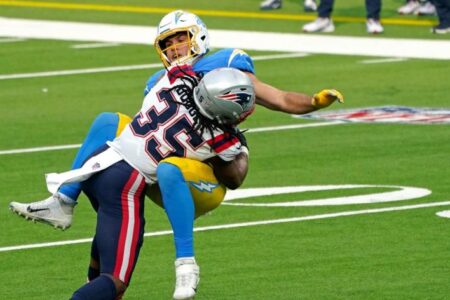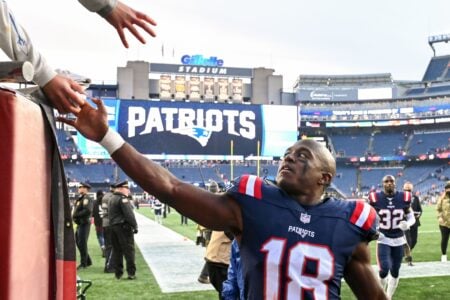I know what my eyes tell me: the Patriots defense is better now than it was earlier in the year. I certainly have more confidence in them now than I did earlier. The switch to Talib/Dennard at CB with McCourty as S really has helped matters out a ton.
At least that's what it looks like to my eyes.
Do the numbers back it up? Unfortunately, no. I broke the season up into two halves: weeks 1-8, then weeks 9-18 (including the playoff game vs. Houston). Here's what I found.
First, the raw numbers:
Points allowed per game:
- Wks 1-8: 21.3
- Wks 9-18: 21.0
(so that's good, right? a little improvement)
Yards allowed per game:
- Wks 1-8: 369.8
- Wks 9-18: 382.1
(so that's bad, right? more yards allowed per game)
But we might want to focus on that 0.3 ppg improvement and say, hey, they're doing better. Well, maybe, maybe not. Let's look at the quality of offenses they faced in those periods of time. I'm going by those offenses' final rankings and averages. Too much of a pain to go through and figure out where those teams were at that point in the season.
Avg Offensive Ranking by Points:
- Wks 1-8: 18.6
- Wks 9-18: 19.8
Avg Offensive Points Scored:
- Wks 1-8: 21.9
- Wks 9-18: 21.1
So they faced slightly worse offenses in terms of scoring, by 0.8 ppg. What about yards produced?
Avg Offensive Ranking by Yards:
- Wks 1-8: 20.9
- Wks 9-18: 18.6
Avg Offensive Yards Gained:
- Wks 1-8: 331.0
- Wks 9-18: 337.0
So their 2nd half opponents tended to gain a few more yards per game than their 1st half opponents did over the course of the entire season.
Now, let's look at the Patriots' performance relative to their opponents' offensive production.
Weeks 1-8:
- The average points scored by their opponents over the course of their (opponents') season was 21.9. The Patriots held them to an average of 21.3. That's a +0.6 figure for the Patriots.
- The average yards gained by their opponents over the course of their (opponents') season was 331.0. The Patriots held them to an average of 369.8. That's a -38.8 figure for the Patriots.
Weeks 9-18:
- The average points scored by their opponents over the course of their (opponents') season was 21.1. The Patriots held them to an average of 21.0. That's a +0.1 figure for the Patriots.
- The average yards gained by their opponents over the course of their (opponents') season was 337.0. The Patriots held them to an average of 382.1. That's a -45.1 figure for the Patriots.
So in both points allowed and yards allowed, the Patriots have been *worse* during the 2nd half of the season than they were during the 1st half of the season, relative to the offensive capability of their opponents.
The numbers here do not support what my eyes tell me.
Now let's see how the Pats have done this year against above-average offenses. They've only played 7 games against offenses in the top 16 in the league: Bal, Den, Sea, Ind, Hou, SF, and Hou again. Here's what they've done in those games:
Avg Rank (Pts): 9.4
Avg Rank (Yds): 10.3
Avg PPG: 25.7
Pats allowed: 26.1
Pats +/-: -0.4
Avg YPG: 367.1
Pats allowed: 407.0
Pats +/-: -39.9
Long story shorter, we have good reason, statistically, to believe that Baltimore will put up both yards and points on the Patriots. It *feels* like the Pats' D is better now than it was earlier in the year, but the numbers suggest that's just not true, unfortunately.
Baltimore averages 24.9 points and 352.5 yards per game this year (regular season numbers). I fully expect them to have around 24-27 points against the Pats on Sunday. I just hope the Pats can put up 28-31 on the Ravens' old and slow defense.
At least that's what it looks like to my eyes.
Do the numbers back it up? Unfortunately, no. I broke the season up into two halves: weeks 1-8, then weeks 9-18 (including the playoff game vs. Houston). Here's what I found.
First, the raw numbers:
Points allowed per game:
- Wks 1-8: 21.3
- Wks 9-18: 21.0
(so that's good, right? a little improvement)
Yards allowed per game:
- Wks 1-8: 369.8
- Wks 9-18: 382.1
(so that's bad, right? more yards allowed per game)
But we might want to focus on that 0.3 ppg improvement and say, hey, they're doing better. Well, maybe, maybe not. Let's look at the quality of offenses they faced in those periods of time. I'm going by those offenses' final rankings and averages. Too much of a pain to go through and figure out where those teams were at that point in the season.
Avg Offensive Ranking by Points:
- Wks 1-8: 18.6
- Wks 9-18: 19.8
Avg Offensive Points Scored:
- Wks 1-8: 21.9
- Wks 9-18: 21.1
So they faced slightly worse offenses in terms of scoring, by 0.8 ppg. What about yards produced?
Avg Offensive Ranking by Yards:
- Wks 1-8: 20.9
- Wks 9-18: 18.6
Avg Offensive Yards Gained:
- Wks 1-8: 331.0
- Wks 9-18: 337.0
So their 2nd half opponents tended to gain a few more yards per game than their 1st half opponents did over the course of the entire season.
Now, let's look at the Patriots' performance relative to their opponents' offensive production.
Weeks 1-8:
- The average points scored by their opponents over the course of their (opponents') season was 21.9. The Patriots held them to an average of 21.3. That's a +0.6 figure for the Patriots.
- The average yards gained by their opponents over the course of their (opponents') season was 331.0. The Patriots held them to an average of 369.8. That's a -38.8 figure for the Patriots.
Weeks 9-18:
- The average points scored by their opponents over the course of their (opponents') season was 21.1. The Patriots held them to an average of 21.0. That's a +0.1 figure for the Patriots.
- The average yards gained by their opponents over the course of their (opponents') season was 337.0. The Patriots held them to an average of 382.1. That's a -45.1 figure for the Patriots.
So in both points allowed and yards allowed, the Patriots have been *worse* during the 2nd half of the season than they were during the 1st half of the season, relative to the offensive capability of their opponents.
The numbers here do not support what my eyes tell me.
Now let's see how the Pats have done this year against above-average offenses. They've only played 7 games against offenses in the top 16 in the league: Bal, Den, Sea, Ind, Hou, SF, and Hou again. Here's what they've done in those games:
Avg Rank (Pts): 9.4
Avg Rank (Yds): 10.3
Avg PPG: 25.7
Pats allowed: 26.1
Pats +/-: -0.4
Avg YPG: 367.1
Pats allowed: 407.0
Pats +/-: -39.9
Long story shorter, we have good reason, statistically, to believe that Baltimore will put up both yards and points on the Patriots. It *feels* like the Pats' D is better now than it was earlier in the year, but the numbers suggest that's just not true, unfortunately.
Baltimore averages 24.9 points and 352.5 yards per game this year (regular season numbers). I fully expect them to have around 24-27 points against the Pats on Sunday. I just hope the Pats can put up 28-31 on the Ravens' old and slow defense.


















